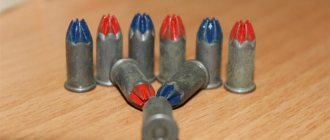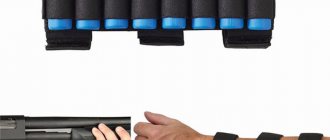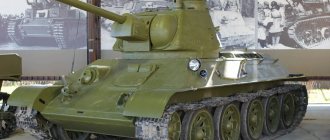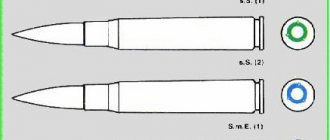- May 27, 2019
- Weapons and ammunition
- Anatoly Chugaev
When purchasing a gun, an experienced hunter will pay attention not only to its appearance. Characteristics play a major role. These include the accuracy and sharpness of the battle. The grip of the gun and its weight will affect the speed of the shot. Before going to the store, you need to carefully understand all this. The gun will accompany the hunter for many years, so the choice needs to be thorough and without fuss.
Determining the sharpness of combat
The sharpness of a shotgun is the ability of a shot to pierce and damage an object. It is checked in conjunction with accuracy and accuracy, and depends on what the speed was when the projectile collided with the target. This determines the fire of the gun and the effectiveness of the shot. At a low speed, the hunter leaves wounded animals, and this is unacceptable.
The sharpness of the battle can be checked in practice in a simple way - measure a distance of 35 meters and set a target. Exactly in its center, but on the other side, planed dry boards are installed. When the shot penetrates the board to a depth of three shot diameters, the sharpness is excellent. At a depth of two diameters the sharpness is good, and at one diameter it is satisfactory. Such studies do not give 100% results, but they help in any conditions to select the required charge and muzzle attachment in a short period of time.
Combat accuracy
We can say that the accuracy of the battle is a certain concentration of pellets towards the center of the target at a specific distance. At the moment of firing, the shot continues to be in a single charge. Only when flying out of the trunk does it gradually diverge to the sides. A sheaf of shot at a distance of 20-30 m has a certain scattering - scattering.
If you examine a shot on a target, you can see a uniform field of scattered pellets with a pronounced concentration towards the center of the target. The shot is aimed at the target. The main sheaf should be close to the center, but the density of the scree varies depending on the distance. With a close shot, the charge does not have time to scatter and passes through in a dense stream, but at a long distance it scatters and does not have a strong damaging force.
Chokes (chokes or bells) are used to regulate the accuracy and sharpness of the gun's fire. The length of the barrel has a significant impact on these indicators.
12 gauge choke table:
| Name of narrowing | How is it designated? | Tags | Amount of contraction |
| Cylinder | C | I | |
| Pressure cylinder | CN | II | 0.25 |
| Payday | 1/2 | III | 0.5 |
| Medium choke | 3/4 | III | 0.75 |
| Full choke | P/H | III | 1.0 |
Manufacturers
Among the most popular manufacturers of chokes, which have already proven themselves to be the best in the world market, we should mention the companies Benelli, Fabarm, Briley, Browning and others.
Chokes from the Tula Defense Plant (TOZ) are in demand on the Russian market.
These companies present a wide range, which includes various types of chokes with pressure, cylinders with pressure, both for hunting and for shotguns used in sports.
Making chokes at home requires a lot of knowledge, care and time. A mistake can be very costly as it can cause an explosion and serious injury. It is best to purchase attachments from trusted manufacturers.
What types of barrel bells are there?
From the table of choke constrictions you can understand what markings and sizes of chokes exist. They are intended for shooting at short distances. They promote the spread of shot and allow you to shoot all shot sizes. Also used when shooting with buckshot and bullets. Can be used when shooting at a bird from the approach; it makes it possible to hunt from a short distance due to the dense scattering of shot.
- The pressure socket has a slight narrowing (in the range of 0.15 - 0.25 mm). In terms of indicators, it is similar to a cylinder and has a higher density. May be called a weak choke. Used for close range shooting.
- Receipt – narrowing of the trunk equal to 0.5 mm. Increases the accuracy of combat, increases the firing range. Symbols and markings are shown in the choke table.
- Medium choke – has a narrowing of 0.75 mm. It is worth remembering that a higher value increases the accuracy of the battle and makes it possible to shoot at long distances, but the shot must be large, since small shot does not have enough energy to cause serious damage.
- Full choke - a narrowing of the barrel equal to 1.00 mm (the full designation is shown in the choke table).
The results for long-distance shooting with large shot are impressive. For example, the legendary semi-automatic MTs 21-12 with a 1.00 mm choke surprised hunters by stopping a medium-sized fur-bearing animal at a distance of 100 meters with shot No. 2-3.
There are less common choke constrictions. They have a narrow specific application. These include: very strong or rifled choke:
- A very strong choke - OSCh (1.25 -1.45) is used by athletes. Designed for shooting small shot at a long distance, which allows you to break the plate.
- The rifled choke (or paradox) is used to fire bullets over long distances. They are mainly in demand among fishermen.
When choosing a nozzle or a gun, the choke markings indicated in the table we provided above will help.
Chock and pay: what is it?
Chok was invented in the 19th century. To better understand the terminology, you should consider the meaning of the concepts chok and pay.
Choke is a narrowing of the muzzle that facilitates shot shooting and affects the accuracy of the shot. It is also called a bell. You need to understand that a strong, medium choke or payoff are very relative guidelines that depend on the manufacturer. For example, a regular choke from various companies may require a narrowing of 0.75, 0.9 or 1 mm.
Gun attachments
In addition to the factory ones, made by drilling the barrel, there are homemade removable chokes with different diameters and parameters. Their advantage is that you can adjust your gun to the upcoming type of hunting. We have given the designation of the choke constrictions in the table.
Many novice hunters are interested in how to select baits. Let us consider this issue in detail, since it is very important for accurately hitting the target.
It is necessary to select nozzles according to the size of the shot. If it is shallow and the muzzle is full of choke, then after 35 meters the energy is lost. This leads to ineffective use of the nozzle. If you use large shot with a small narrowing of the trunk, you will get a wide scree. It is highly likely that game will pass through it without being damaged.
At a distance of no more than 30 meters, it makes no sense to use a full choke. At a distance of 40-50 meters, such a narrowing will be effective. Large-sized shot will be correctly used with strong chokes, while small shot will lose its destructive power under such conditions.
Read more
Psychology of a shot When they talk about the psychological preparation of a shooter, for some reason the vast majority perceive it as something that relates exclusively to sports, and moreover, to the sport of high achievements. In fact, psychological preparation, or more precisely, psychological readiness to shoot, is just as important for a hunter. 04/24/2018 Tournament of four, or chasing away the “cockroaches” Sometimes while hunting or at a stand you see a characteristic picture. A hunter or shooter who suddenly runs out of ammunition asks his comrade to give him some. 05/08/2020
Read also: State in the northern USA, 9 (nine) letters
Which choke constrictions for which shot?
For each type of hunting (and season) they choose their own choke and shot number. For example, duck hunting in early autumn takes place in its nesting areas. The bird reluctantly takes wing and takes off at close distances, tries to dive or hide in the reeds. For such hunting, use a nozzle with the least narrowing, and shot No. 6 and No. 7 will be the most suitable. When hunting ducks on migration in mid-autumn, a half-shot or choke and large shot No. 3 and No. 5 are suitable.
Before hunting, it is very important to place the target at different distances and fire several test shots. When examining the targets, you will be able to understand the accuracy and distribution of these charges. This will increase hunting efficiency. It would also be a good idea to practice on the bench to understand what lead is suitable when shooting at a longer distance. If you take into account all these factors and take the time to train, the result will be pleasantly surprising.
On forums and in reviews, hunters share their experiences and impressions about the functionality of various types of weapons. They also describe various situations. For example, there are cases when beginners in this business prepare decoys, equipment, and train dogs, but they approach the choice of shot incorrectly, buying the one that (in their opinion) “hits for sure.” When they start shooting at game, there is no result. It turns out that their cartridge is equipped with a container, shot No. 3 when the barrel is narrowed for No. 5, and shots occur at a distance of 10-15 meters.
If you pay attention to theory, practice will be more fun.
Major chokes manufacturers
The largest manufacturers of chokes are the well-known arms companies Benelli, Browning, Fabarm and others. In the Russian segment, the greatest demand among hunters is for choke tubes from the Vyatsko-Polyansky Machine-Building Plant and TOZ (Tula Defense Plant).
Chokes from lesser-known brands from Western factories are also popular in Russia:
- Comp-N-Choke - the company produces chokes for hunting and sporting shotguns, from 10 to 20 gauge;
- Briley has a huge range of chokes, from push chokes to strong chokes. Chokes are produced for most popular types of shotguns, a system of discounts has been implemented for regular customers and convenient delivery anywhere in the world within 1 month;
- Kick's - Mainly makes bird shooting choke tubes for 10 gauge and 12 gauge. Choke tubes are available in a variety of sizes, from pressure cylinders to pressure chokes.
In general, the appearance on the arms market of interchangeable choke tubes with different constrictions allowed hunters and sports shooters to achieve any intended goals in the field of accuracy and shot range. Nowadays, few shotgun manufacturers can do without their own line of choke tubes.
Some hunters produce them themselves, but this is a painstaking and very dangerous task. An incorrect attachment can cause the barrel to explode and cause serious injury. We recommend purchasing chokes only from trusted manufacturers. Have a good hunting!
Muzzle constrictions for a bullet
During driven hunts, the most common weapon is a smoothbore weapon. Perhaps this is due to its versatility. However, some experts believe that the result always depends on experience.
To understand in detail what bullet and choke are needed for an accurate shot, you will need additional information. The fact is that there are caliber and sub-caliber bullets. Their difference is that the first is equal to the diameter of the trunk, and the second has a smaller diameter. The table of choke constrictions given above will help you understand all the subtleties in this matter.
Polichok
This device is a nozzle that is screwed onto the muzzle of the barrel. The base consists of a base, which is screwed onto the muzzle of the barrel, and a coupling with a cone-shaped inner surface. At the junction of the coupling, the base of the polychok is equipped with a relatively thin tube. The tube is cut into six petals along the polychok axis. On the outer surface of these petals there is also a cone, which is connected to the coupling. Thanks to special heat treatment, the petals of the tube are always selected so that the internal diameter of the base coincides with the diameter of the barrel bore. Then, in the most weakened state, the gun provides accuracy of fire corresponding to the cylinder. By turning the clutch, you can achieve a mild to full choke effect. Thus, one nozzle replaces all the most common types of choke constrictions, allowing the hunter to decide on the spot which choke to use. tend to unclench and return to their original position.
How to choose the right bullet cartridge
To choose the right bullet, it is enough to know the diameter of the barrel drill. This figure may vary among different manufacturers. For example, domestically produced shotguns of the same caliber IZH and TOZ have different diameters. For example, the drilling length of a 12-gauge IZH barrel is 18.2 mm, and that of a TOZ is 18.5 mm.
If a person uses an IZH gun, then the bullet for him will be caliber. Let's say he bought himself a TOZ weapon. If a person wants to use the same bullets for his purchase, they will become sub-caliber. This should definitely be taken into account.
Note that with a looser drilling (18.5 mm), the sub-caliber bullet is compared with the caliber bullet if there are constrictions of 0.75 and 1.00. At the same time, she hits the target directly. The accuracy of the hit depends on the density of the bullet passing through the barrel. There are different choke calibers, but the most popular remains 12. It is distinguished by its optimal charge weight and versatility.










